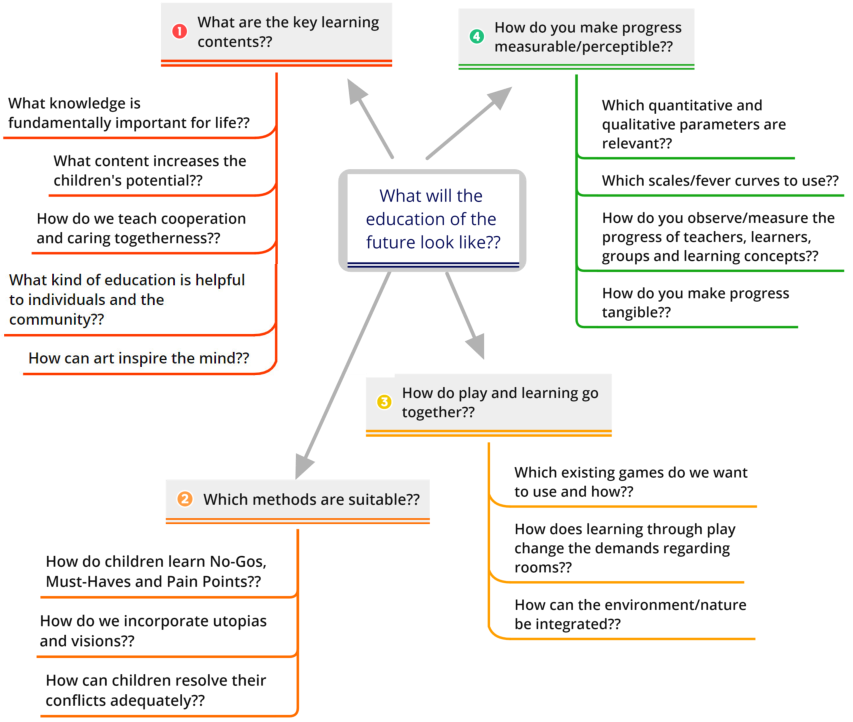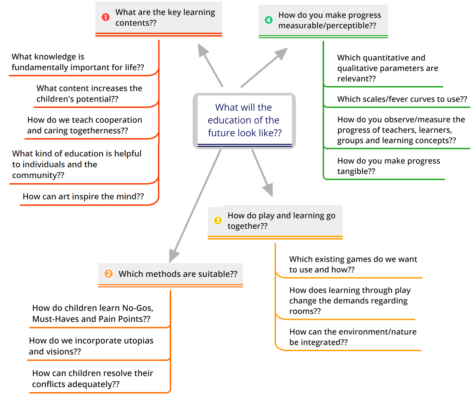StrategyMap


How to turn your team
into the boss


- The 6 Hurdles
- The Elements
- What are the Elements
- Culture Stage Model
- Gut, Head or Herart Process
- Culture Change
- List of Feelings and Needs
- Emergency Emo-Step
- Four Step Circle
- NVC Magic Circle
- Utopia Magic Circle
- Utopia and Vision
- No-Goes and Must-Haves
- Pain Points
- Consensus
- Requirement Lists
- NVC-plus Strategy
- NVC-plus Matrix
- Discourse
- Card Set
- Download-Tool-Depot
- FAQs
- Events
- Media

6 Hurdles to Self-Organization
Chapter 27 - The StrategyMaps



Home / hurdle 6: integral management / strategymaps
Successful
cooperation
is
both
a
path
and
a
goal.
Good
methods
and
tools
make
it
much
easier
for
a
team
to
organize
itself.
Encourage
your
team
to
take
the
first
steps
in this direction and experience the difference.
The strategy you decide on shouldn't mess with freedom

As
long
as
you
have
enough
power
over
people,
you
can
use
them
for
strategies
that
they
did
not
develop
themselves,
that
do
not
suit
them,
and
that
lead
to
results
they
do
not
approve
of.
It's
like
a
game
of
chess.
One
person
thinks
and
moves
their
pieces
on
the
board.
When
entrepreneurs
today
get
upset
that
people
behave
like
wooden
figures,
don't
think
for
themselves,
and
show
no
initiative,
it
may
be
because
these
people
have
been
standing
around
on
a
chessboard
for
too
long.
What
can
be
done
about
this?
If
you
look
closely
enough,
you
wonder
who
is
actually
still
playing
among
all
the
pieces.
And
there
is
another
problem.
In
an
increasingly
complex
and
diverse
game,
individual
strategists
no
longer
have
a
sufficient
overview
of
the
situation
to
be
able
to
establish
a
central
control
system
that
works.
What
is
needed,
therefore,
is
a
new
form
of
strategy that integrates the intelligence of the entire team or the entire community.
Strategic talent
There
are
not
an
excessive
number
of
individuals
in
a
group
who
possess
strategic
talent.
One
could
argue
that,
in
principle,
anyone
who
can
distinguish
white
from
black
can
play
chess.
To
this,
one
could
respond
that,
of
course,
almost
anyone
can
lose
at
chess.
However,
to
win
at
an
appealing
level,
you
need
a
suitably
gifted,
trained,
and
informed
mind
that
is
comfortable
in
the
abstract
realm
of
strategy.
The
same
is
true
of
the
visionaries
in
a
society.
These
people
should
be
identified
and
then
employed
for
visioning
and
strategic
planning.
If
a
team
wants
to
use
NVC-
plus
to
manage
itself
against
this
backdrop,
the
question
arises
as
to
whether
this
is
a
contradiction.
Self-management
and
following
a
strategy
developed
by
someone
else.
To
resolve
this paradox, we have developed the NVC-plus strategy.
The Strategy Map
The
NVC-plus
strategy
aims
to
bring
everyone's
skills
together
in
an
inclusive
way.
However,
everyone
should
retain
their
freedom
of
choice
without
straying
from
the
course
of
the
shared
vision.
How
do
we
do
that?
It's
simple.
The
StrategyMap
consists
only
of
questions,
or
more
precisely,
a
concentric
set
of
questions.
The
StrategyMap
starts
with
the
central
question
that
needs
to
be
answered
by
everyone's
actions.
For
example,
a
few
people
are
founding
a
new
educational
institute.
What
is
the
central
strategic
question
for
this
institute?
Perhaps
the
strategists
start
with:
“What
does
the
education
of
the
future
look
like?”
Then
the
strategists
consider
how
play
and
learning
are
related
and,
at
the
next
level,
they
ask
the
question:
“How
can
education/teaching
be
made
more
fun?”
And:
“How
do
we
measure
progress?”
This
is
followed
by
another
branch.
There,
a
question
might
be:
“How
are
play
and
learning
connected?”
and “Which existing games do we want to use and how?” etc.
There
should
be
as
few
questions
as
possible,
and
these
should
be
arranged
in
a
logical
order.
The
ongoing
task
is
to
optimize
this
strategic
plan,
particularly
to
improve
the
questions,
move
them
to
other
levels
if
necessary,
and
add
any
missing
questions.
Feedback
from
practitioners
helps
the
strategists
in
this
process.
The
end
result
is
a
very
small
set
of
strategic
questions
that
is
made
available
to
practitioners
and
implementers.
As
long
as
employees
provide
good
“answers”
to
the
questions
through
their
actions,
they
will
always
act
within
the
framework
of
the
strategy
without anyone telling them what to do. In other words, they have control without losing freedom.

Every team, start-up, or company must overcome these six hurdles if it wants to organize itself
collegially in order to successfully manage projects from within the community.
StrategyMap





b) StrategyMap


Chapter 27 - The StrategyMaps


- The 6 Hurdles
- The Elements
- What are the Elements
- Culture Stage Model
- Gut, Head or Herart Process
- Culture Change
- List of Feelings and Needs
- Requirement Lists
- NVC Magic Circle
- Utopia Magic Circle
- Emergency Emo-Step
- Four Step Circle
- Utopia and Vision
- No-Goes and Must-Haves
- Pain Points
- Consensus
- NVC-plus Strategy
- NVC-plus Matrix
- Discourse
- Card Set
- Download-Tool-Depot
- FAQs
- Events
- Media
Successful
cooperation
is
both
a
path
and
a
goal.
Good
methods
and
tools
make
it
much
easier
for
a
team
to
organize
itself.
Encourage
your
team
to
take
the
first
steps
in
this
direction and experience the difference.
The strategy you decide on shouldn't
mess with freedom
As
long
as
you
have
enough
power
over
people,
you
can
use
them
for
strategies
that
they
did
not
develop
themselves,
that
do
not
suit
them,
and
that
lead
to
results
they
do
not
approve
of.
It's
like
a
game
of
chess.
One
person
thinks
and
moves
their
pieces
on
the
board.
When
entrepreneurs
today
get
upset
that
people
behave
like
wooden
figures,
don't
think
for
themselves,
and
show
no
initiative,
it
may
be
because
these
people
have
been
standing
around
on
a
chessboard
for
too
long.
What
can
be
done
about
this?
If
you
look
closely
enough,
you
wonder
who
is
actually
still
playing
among
all
the
pieces.
And
there
is
another
problem.
In
an
increasingly
complex
and
diverse
game,
individual
strategists
no
longer
have
a
sufficient
overview
of
the
situation
to
be
able
to
establish
a
central
control
system
that
works.
What
is
needed,
therefore,
is
a
new
form
of
strategy
that
integrates
the
intelligence
of
the
entire
team
or
the
entire
community.
Strategic talent
There
are
not
an
excessive
number
of
individuals
in
a
group
who
possess
strategic
talent.
One
could
argue
that,
in
principle,
anyone
who
can
distinguish
white
from
black
can
play
chess.
To
this,
one
could
respond
that,
of
course,
almost
anyone
can
lose
at
chess.
However,
to
win
at
an
appealing
level,
you
need
a
suitably
gifted,
trained,
and
informed
mind
that
is
comfortable
in
the
abstract
realm
of
strategy.
The
same
is
true
of
the
visionaries
in
a
society.
These
people
should
be
identified
and
then
employed
for
visioning
and
strategic
planning.
If
a
team
wants
to
use
NVC-plus
to
manage
itself
against
this
backdrop,
the
question
arises
as
to
whether
this
is
a
contradiction.
Self-
management
and
following
a
strategy
developed
by
someone
else.
To
resolve
this
paradox,
we
have
developed
the
NVC-plus
strategy.
The Strategy Map
The
NVC-plus
strategy
aims
to
bring
everyone's
skills
together
in
an
inclusive
way.
However,
everyone
should
retain
their
freedom
of
choice
without
straying
from
the
course
of
the
shared
vision.
How
do
we
do
that?
It's
simple.
The
StrategyMap
consists
only
of
questions,
or
more
precisely,
a
concentric
set
of
questions.
The
StrategyMap
starts
with
the
central
question
that
needs
to
be
answered
by
everyone's
actions.
For
example,
a
few
people
are
founding
a
new
educational
institute.
What
is
the
central
strategic
question
for
this
institute?
Perhaps
the
strategists
start
with:
“What
does
the
education
of
the
future
look
like?”
Then
the
strategists
consider
how
play
and
learning
are
related
and,
at
the
next
level,
they
ask
the
question:
“How
can
education/teaching
be
made
more
fun?”
And:
“How
do
we
measure
progress?”
This
is
followed
by
another
branch.
There,
a
question
might
be:
“How
are
play
and
learning
connected?”
and
“Which
existing
games
do
we
want
to
use
and
how?”
etc.
There
should
be
as
few
questions
as
possible,
and
these
should
be
arranged
in
a
logical
order.
The
ongoing
task
is
to
optimize
this
strategic
plan,
particularly
to
improve
the
questions,
move
them
to
other
levels
if
necessary,
and
add
any
missing
questions.
Feedback
from
practitioners
helps
the
strategists
in
this
process.
The
end
result
is
a
very
small
set
of
strategic
questions
that
is
made
available
to
practitioners
and
implementers.
As
long
as
employees
provide
good
“answers”
to
the
questions
through
their
actions,
they
will
always
act
within
the
framework
of
the
strategy
without
anyone
telling
them
what
to
do.
In
other
words,
they
have control without losing freedom.








































